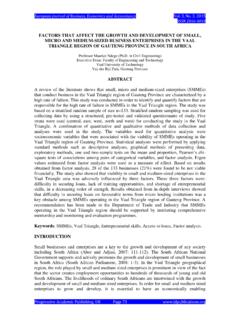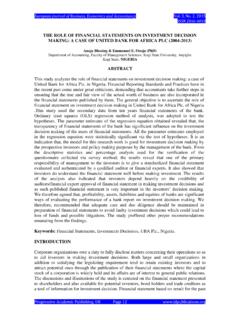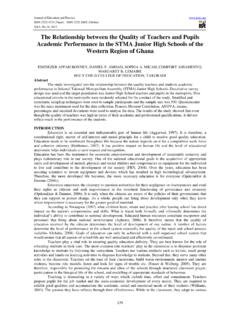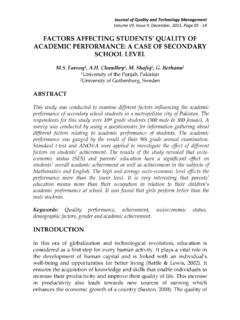Transcription of FACTORS CONTRIBUTING TO SCHOOL DROPOUT AMONG …
1 European Journal of Research and Reflection in Educational Sciences Vol. 3 No. 2, 2015 ISSN 2056-5852 Progressive Academic Publishing, UK Page 25 FACTORS CONTRIBUTING TO SCHOOL DROPOUT AMONG THE GIRLS: A REVIEW OF LITERATURE S. M. Shahidul International Islamic University of Malaysia MALAYSIA A. H. M. Zehadul Karim International Islamic University of Malaysia MALAYSIA ABSTRACT Though a lot of research have been concerned with SCHOOL DROPOUT issue for both girls and boys, DROPOUT pattern significantly differs by the gender of the students. This paper clarifies the FACTORS that contribute to the increasing DROPOUT rate of children, particularly AMONG girls by making a detailed review of available literature. Most past reviews on the SCHOOL DROPOUT issue have been carried out regardless of the gender of the students.
2 A few of the studies in this context have been done on girls' DROPOUT outcome based on particular regions and cultures of the world. In this paper, we identify the FACTORS and illustrate a conceptual model for girls' DROPOUT from SCHOOL . We demonstrate that though some FACTORS can cause an increase in the DROPOUT rate regardless of the gender of students, these FACTORS mainly contribute to an increase in the DROPOUT rate particularly for female students. In our conceptual model we try to illustrate how a range of particular FACTORS can affect students' educational outcome which consequently produce DROPOUT AMONG girls in schools in general. And finally, we provide a few recommendations which policy planners may adopt in reducing girls' DROPOUT from schools.
3 Keywords: SCHOOL DROPOUT , girls' education, educational inequality. INTRODUCTION The development of a society can be judged by measuring the issues that extend educational inequality prevalent in the society. The prevalence of unequal distribution of education in male and female students hinders the development at every stage of a nation. According to the World Conference on Education (2001), all children, particularly girls, must have access to and complete quality education by the year 2015. We know it very well that both boys and girls have equal right to be educated and in developing a nation it is important to provide education irrespective of gender. a growing body of literature shows that girls' DROPOUT rates are higher compared to boys' in most parts of the world.
4 For instance, according to UNESCO (2012), the DROPOUT rate is higher for girls in 49 countries compared to boys. Chimombo (1999) observes that though the enrolment in SCHOOL is almost same for girls and boys, boys have a higher likelihood of continuing SCHOOL compared to girls. Holmes (2003) also found that girls overall attain less education and tend to drop out earlier as compared to boys. Thus, when DROPOUT rate varies by gender and if girls tend to drop out earlier compared to boys, it manifests that there are some unique FACTORS CONTRIBUTING to the increase in the DROPOUT rate, particularly for girls. In other words, there are some FACTORS which extensively contribute to an increase in girls' DROPOUT though those FACTORS also impact DROPOUT rate for boys.
5 In this respect, European Journal of Research and Reflection in Educational Sciences Vol. 3 No. 2, 2015 ISSN 2056-5852 Progressive Academic Publishing, UK Page 26 the findings of Holcamp (2009) also support our argument when the author found that some socio-cultural FACTORS highly impact girls' DROPOUT rate though those FACTORS also contribute to boys' DROPOUT rate but to a lesser extent. Therefore, we can argue that some particular FACTORS produce poor educational outcome which consequently increase the DROPOUT rate for girls. Therefore, from this viewpoint, the main objective of this paper is to clarify which FACTORS contribute to the increase in the DROPOUT rate, particularly AMONG girls which are not quite clear in past reviews on the DROPOUT issue.
6 DROPOUT rate does not occur through a single factor; it is a composition of several FACTORS . A number of studies have been conducted on girls' DROPOUT issue based on particular regions, societies and cultural perspectives in various parts of the world. In this paper, we accumulate the FACTORS and illustrate a conceptual model of DROPOUT for girls which can give further opportunity to researchers to view the relevant FACTORS on girls' DROPOUT issue. For better demonstration we have divided all the FACTORS into four groups which are (1) economic FACTORS , (2) household level FACTORS , (3) SCHOOL level FACTORS and (4) cultural FACTORS . ECONOMIC FACTORS Parental Investment Parental investment for children's well-being can sometimes become gender biased.
7 Although parents are altruistic to the gender of their children, they do not invest in education equally for all. In this regard, there are considerable evidences in the literature (Glick & Sahn, 2000; Kingdon, 2005) supporting this view whereby that, there is gender bias or pro-male bias in case of parental investment in children. In addition, Leung and Zhang (2008) found that parents' preference for sons encourage more of them to invest for in their sons' well-being to take care of parents in the future. In fact, parental gender bias investment occurs particularly when parents have limited/lower income and resource, causing girls to leave SCHOOL earlier than boys. For instance, Fuller and Laing (1999) and Grant and Hallman 2006) found an association between a family s financial strength and the likelihood of the daughter's DROPOUT in South Africa.
8 Schooling Costs Direct and indirect schooling costs are important FACTORS for the education of children and some research indicate that schooling costs especially SCHOOL fees, are a central reason for early DROPOUT from schools. Schooling costs are sometimes linked to the gender of the children as parents are sometimes become unwilling to pay schooling fees for their daughters. For instance, Brown and Park (2002) investigated that in rural China, parents' incapability to pay compensate SCHOOL fees was the reason for the DROPOUT of 47% of girls while only 33% of boys DROPOUT in elementary schools; in junior secondary high SCHOOL , fees were half for the girls but only 8% for the boys. Hunter and May (2002) found that SCHOOL fees were significant reason for the DROPOUT rate of 27% of boys but 30 % of girls before secondary SCHOOL graduation in South Africa.
9 From the families perspective, Shovan Ghosh Susmita & Sengupta (2012) observe that in poor households in India, the costs of schooling for girls are likely to be higher while the benefits more tenuous for them than the boys. The authors also observe that though direct costs are similar for boys and girls, parents are less willing to spend on girls. Lloyd et. al. (2000) also found that in Kenya, higher SCHOOL fees increases the likelihood of dropping out for girls but not for boys. European Journal of Research and Reflection in Educational Sciences Vol. 3 No. 2, 2015 ISSN 2056-5852 Progressive Academic Publishing, UK Page 27 HOUSEHOLD LEVEL FACTORS Household Work There is substantial literature regarding how a child' work impacts on educational outcome regardless of the gender of the children.
10 Many studies observe that girls sometimes begin working at an earlier age than boys especially in rural areas and girls also tend to do more work in the household than boys. Studies indicate that female students tend to drop out of SCHOOL to take care of their younger siblings (Brock & Cammish, 1997). Another study found that if children less than 6 years old are present at home, elder sisters are more likely to drop out (Canagarajah & Coulombe, (1997). Another research indicates that if mothers work and get wage outside of the home, Female children take some responsibilities of the household which causes them to drop out, Fuller & Liang (1999). In general, girls take more load of household chores than the boys and on the other hand rural girls do more household works than urban girls (Ersado, 2005).)












